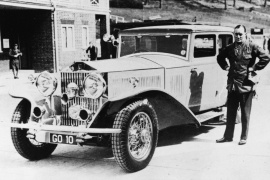Segment: Luxury
Production years: 1929, 1930, 1931, 1932, 1933, 1934, 1935, 1936
 2 Photos
2 PhotosThe second generation of the Phantom appeared during the harsh time of the Great Depression that started in September 1929, but despite that, it was a successful model being produced until 1936 in almost 1,700 units.
It was the last brainchild of Sir Henry Royce, the head of his company’s design department, and was a big improvement over the first generation of the Phantom that was launched in 1925. Even if it didn’t match the sales of that model, it remained the last inline-six-powered Rolls-Royce that roared the roads of the world before WWII. Furthermore, it introduced several significant technical upgrades that transformed the vehicle into a reliable, comfortable, and quiet vehicle. These attributes made it a sought-after luxury car for the rich and wealthy from that era and the last Rolls-Royce to sell in over 1,000 units before the war turned the world upside down.
In those times, it was very usual for customers to order their cars from the factory as rolling chassis and get them equipped with custom-made bodyworks made by coachbuilders. Still, Rolls-Royce had some strict requirements, and only a handful of companies were allowed to finish the vehicles. Still, there were a few distinct elements that came with the vehicle, such as the tall, straight-up radiator with the Spirit of Ecstasy statue mounted on top of it. As a result, the Phantom II came fitted with a long engine compartment that featured louvers on the sides to help cool the powerplant.
From its profile, the Phantom II sported a tall greenhouse with an almost vertical windshield. The Landaulet versions featured a removable leather cover for the front compartment and a retractable roof for the rear-seated ones. Behind the vehicle, Rolls-Royce created a special rack for a removable trunk so customers could get it as a whole, so they didn’t have to load the car. Just the trunk and have it attached to the vehicle. Depending on the options, customers could fit the vehicle with spare wheels mounted on the sides of the engine bay or behind the cabin and the removable trunk. Thanks to the newly designed chassis, the car sat lower to the ground than the Phantom I.
Inside, the only mandatory items were the dashboard and the driving post. Rolls-Royce installed the main dials in the middle of the dash panel with a large speedometer that could be read even by the rear-seated passengers. The four-spoke wooden steering wheel sported the controls for the ignition timing in its middle. All vehicles were fitted with a right-hand driving post, and the gear-stick was mounted on the floor, on the right side of the cabin.
The car’s underpinnings were excellent for those times. It featured new, semi-elliptic leaf springs on both axles and a central lubrication system. Under the hood was an OHV push-rod engine with cross-flow that produced 120 PS (118 hp). It sent the power to the rear wheels via a four-speed manual transmission. Furthermore, the Phantom II was the first Rolls-Royce to have its gearbox directly attached to the engine.
ROLLS-ROYCE Phantom II 1929, 1930, 1931, 1932, 1933, 1934, 1935, 1936
- 7.7
ROLLS-ROYCE Phantom II
7.7
ENGINE SPECS - 7.7 | |
|---|---|
| Cylinders: | L6 |
| Displacement: | 7668 cm3 |
| Power: | 88 KW @ 3000 RPM 120 HP @ 3000 RPM 118 BHP @ 3000 RPM |
| Fuel System: | Carburetor |
| Fuel: | Gasoline |
PERFORMANCE SPECS | |
|---|---|
| Top Speed: | 92 mph (148 km/h) |
TRANSMISSION SPECS | |
|---|---|
| Drive Type: | Rear Wheel Drive |
| Gearbox: | Manual, 4 Speed |
BRAKES SPECS | |
|---|---|
| Front: | Drums |
| Rear: | Drums |
TIRES SPECS | |
|---|---|
| Tire Size: | 7.00x21 |
DIMENSIONS | |
|---|---|
| Length: | 220 in (5588 mm) |
| Width: | 60 in (1524 mm) |
| Front/rear Track: | 60/63.5 in (1,524/1,613 mm) |
| Wheelbase: | 144 in (3658 mm) |

